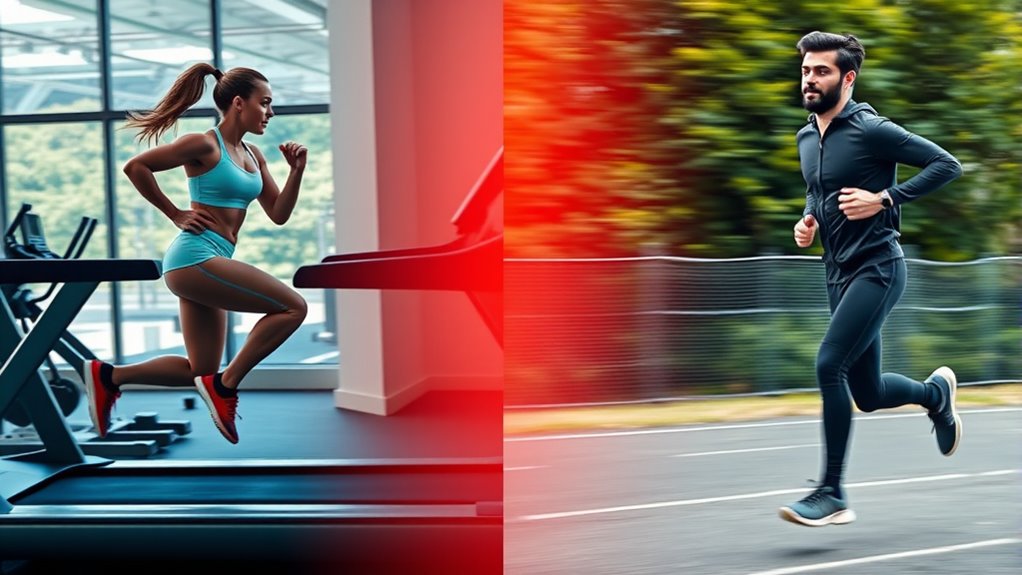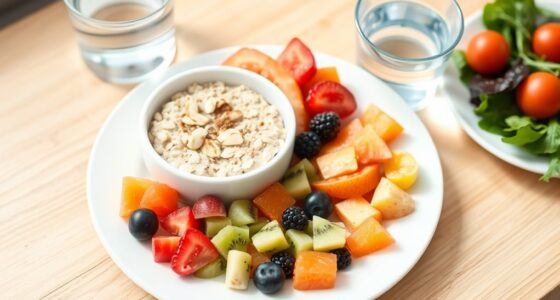If you want to burn more fat, HIIT often comes out ahead because it boosts calorie burn during and after workouts thanks to EPOC, while also promoting muscle preservation. It’s more time-efficient, with shorter sessions that still maximize fat oxidation. Steady-state cardio is effective too, especially for endurance, but usually requires longer workouts. To discover how both can fit into your goals and routines, keep exploring more insights.
Key Takeaways
- HIIT boosts post-exercise calorie burn through EPOC, leading to higher long-term fat oxidation than steady-state cardio.
- Both methods burn calories effectively; HIIT achieves similar fat loss in less time due to higher intensity.
- HIIT promotes muscle engagement and hypertrophy, supporting fat loss while preserving muscle mass.
- Steady-state cardio burns a larger percentage of fat during exercise but may require longer sessions to match HIIT’s calorie burn.
- Combining HIIT with proper nutrition maximizes fat loss, but both approaches can be effective depending on individual goals and preferences.
Understanding the Basics of HIIT and Steady-State Cardio

Have you ever wondered how different cardio workouts impact your body? High-Intensity Interval Training, or HIIT, involves quick bursts of intense effort followed by short recovery periods. These sessions usually last under 30 minutes and include exercises like running, jumping rope, or rowing, with efforts reaching at least 80% of your max heart rate. In contrast, steady-state cardio keeps your effort steady and moderate, typically between 50% and 70% of your max heart rate, for 20 to 60 minutes. It involves activities like jogging, cycling, or swimming. HIIT primarily activates your anaerobic energy systems, promoting explosive power, while steady-state cardio relies on aerobic metabolism, enhancing endurance. Both methods stimulate different energy pathways and produce unique physiological effects.
How Each Method Influences Fat Burning Efficiency

Both HIIT and steady-state cardio impact fat burning differently, especially when it comes to maximizing efficiency. HIIT requires less time to deliver comparable improvements in body fat percentage because of its high-intensity intervals and elevated post-exercise oxygen consumption (EPOC), which keeps your metabolism elevated longer. This “after-burn” effect boosts fat oxidation even after your workout ends. Additionally, HIIT increases muscle mitochondria, improving overall metabolic efficiency and muscle engagement, which supports long-term fat loss. While steady-state cardio burns a significant number of calories during exercise, it doesn’t produce the same metabolic boost afterward. Overall, HIIT’s combination of intensity, efficiency, and muscle engagement makes it a more effective method for optimizing fat burning, especially if time is limited.
Calorie Burn: Comparing Duration and Intensity
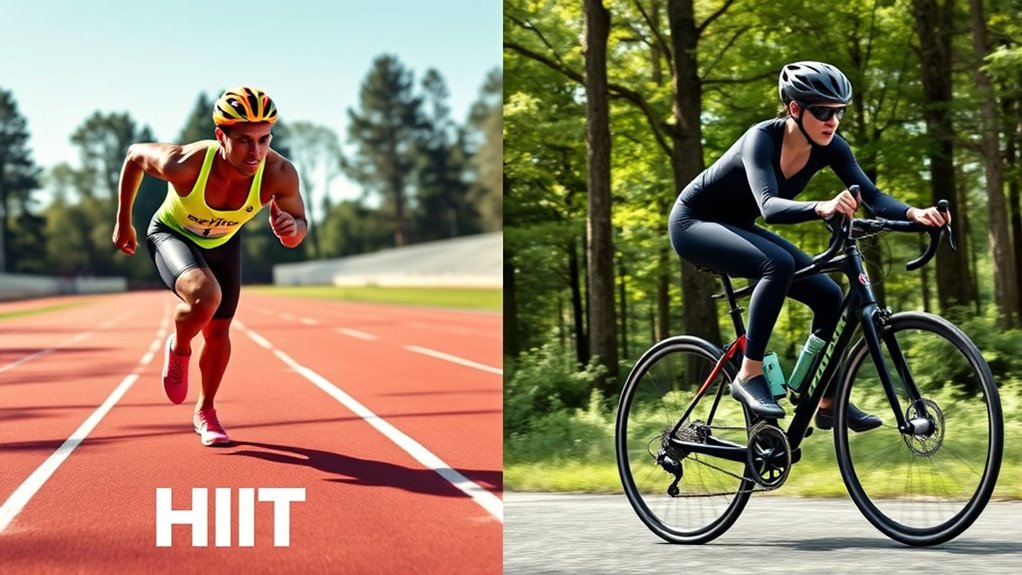
When comparing calorie burn between HIIT and steady-state cardio, the key difference lies in how duration and intensity influence overall expenditure. HIIT involves short, intense bursts at 80-95% of your max heart rate, boosting calorie burn during the workout and elevating your metabolism afterward. These sessions last 10-30 minutes but deliver high calorie expenditure thanks to intensity and fast-twitch muscle engagement. Conversely, steady-state cardio maintains a moderate effort over a longer period, typically 30-60+ minutes, burning calories steadily and primarily using fat as fuel. While HIIT burns more calories in less time, longer steady-state workouts can match or surpass total calorie burn, especially when performed consistently. Both methods are effective, but their efficiency depends on your available time and fitness goals. Incorporating protective styling benefits from various workout routines can help prevent injury and promote recovery. Additionally, understanding the role of credit card security measures can ensure your financial information remains protected during online fitness purchases or memberships. Regularly monitoring your heart rate during exercise can optimize workout effectiveness and safety.
The Role of Post-Exercise Oxygen Consumption (EPOC) in Fat Loss
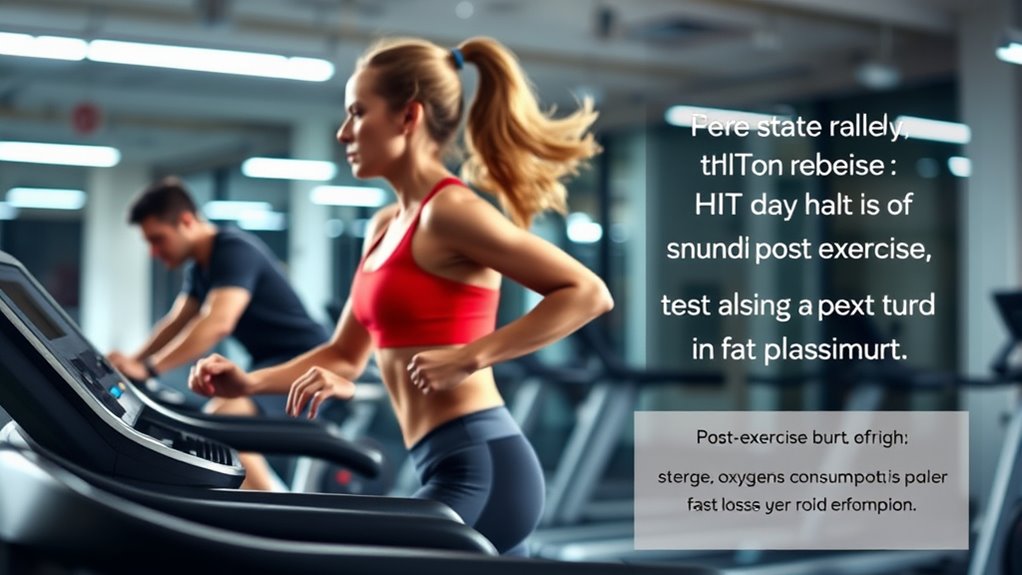
Post-exercise oxygen consumption (EPOC), also known as the afterburn effect, plays a crucial role in fat loss by increasing your body’s calorie expenditure after workouts. When you push yourself hard, especially during high-intensity or anaerobic exercises, your body needs extra oxygen to recover, replenish energy stores, and repair tissues. This elevated oxygen consumption can last for hours, boosting your metabolism and fat oxidation. HIIT, with its intense bursts, induces a higher and longer-lasting EPOC compared to steady-state cardio. While not the primary calorie burner during exercise, EPOC adds up over time, helping create a calorie deficit essential for fat loss. Incorporating high-intensity workouts maximizes EPOC benefits, making it a powerful tool in your fat-burning arsenal. Additionally, understanding the Law of Attraction principles can help reinforce your motivation and mental focus during your fitness journey, aligning your mindset with your goals. To further enhance fat burning, combining EPOC with glycolic acid treatments can improve skin texture and promote a more toned appearance, especially when paired with consistent exercise routines. Moreover, being aware of regional divorce statistics can provide perspective on how different communities experience life changes, which can influence your motivation and mental resilience during challenging periods. Recognizing the importance of recovery strategies can also support sustained fat loss and overall performance.
Muscle Preservation and Gains Through Different Cardio Styles
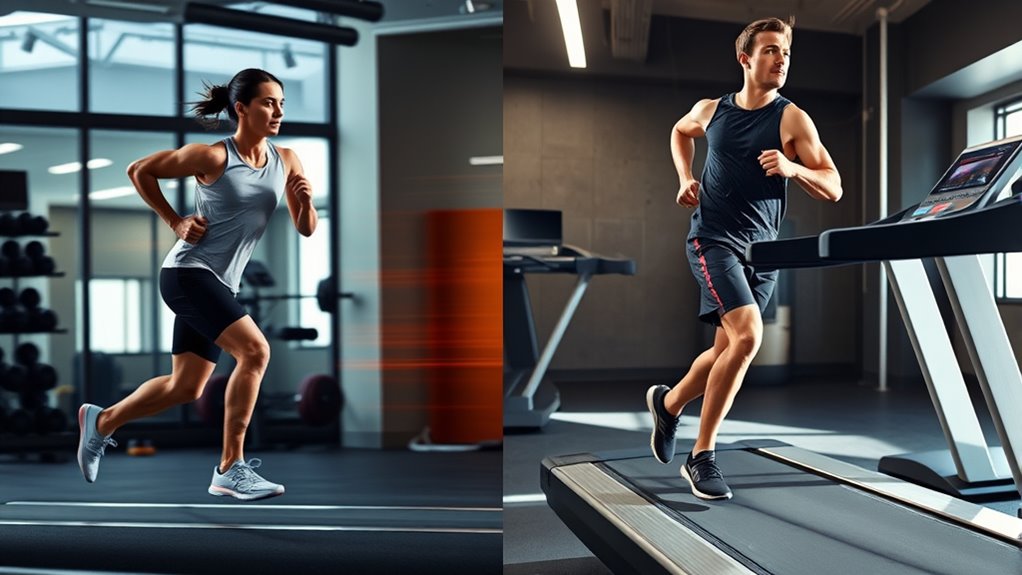
Choosing the right cardio style can substantially impact your ability to preserve and build muscle. HIIT is less likely to cause muscle loss than steady-state cardio, especially when combined with strength training. Its explosive movements engage muscles more effectively, helping you maintain lean muscle mass during fat loss. In contrast, steady-state cardio, being moderate and prolonged, can increase muscle breakdown if done excessively without resistance training. HIIT workouts often incorporate resistance elements, supporting muscle gains alongside fat burning. This style of training stimulates muscle hypertrophy due to high-intensity intervals and embedded resistance, unlike steady-state cardio, which rarely promotes muscle growth. Additionally, HIIT boosts anabolic hormones like testosterone and growth hormone, aiding muscle preservation and development. Furthermore, training intensity plays a crucial role in determining whether you preserve or lose muscle during your cardio sessions. Incorporating proper rest and recovery strategies is also essential for maximizing muscle gains while burning fat. Overall, HIIT offers superior benefits for maintaining and gaining muscle while burning fat.
Long-Term Adherence and Sustainability Factors

Long-term adherence to a cardio routine depends heavily on how sustainable and manageable it feels over time. HIIT offers time-efficient workouts, but its high intensity can make recovery challenging, leading some to lose motivation. Steady‑state cardio, with its lower intensity, tends to be more enjoyable and easier to stick with, especially for beginners or those with joint issues. It also carries fewer injury risks and is more accessible, supporting consistent participation. Incorporating variety by alternating between both styles can prevent boredom and reduce overuse injuries, enhancing sustainability. Personal preferences, social support, and the ability to track progress also play essential roles in maintaining long-term motivation. Additionally, understanding Kia Tuning options can motivate individuals to stay active by personalizing their workouts or vehicle modifications, making exercise routines more engaging and aligned with personal interests. Moreover, emphasizing cultural significance in your routines can foster a deeper connection to physical activity, increasing the likelihood of long-term commitment. Consistently monitoring your progress helps reinforce motivation and demonstrates tangible results, encouraging ongoing commitment. Ultimately, choosing a routine that aligns with your lifestyle and enjoyment ensures better adherence over time.
Additional Health Benefits Beyond Fat Reduction

Beyond fat loss, both HIIT and steady-state cardio offer significant health benefits that support overall well-being. HIIT improves your heart health by lowering blood pressure and increasing cardiovascular efficiency through alternating intensity, while steady-state cardio strengthens your aerobic capacity, helping you utilize oxygen better and lowering your resting heart rate. HIIT may also boost arterial flexibility by promoting rapid blood flow changes, and steady-state can reduce LDL cholesterol, lowering your risk of heart disease. Both workouts raise HDL cholesterol, with HIIT often showing faster improvements. Additionally, HIIT’s high-intensity nature increases calorie burn after exercise and enhances insulin sensitivity, aiding blood sugar regulation. Steady-state helps with metabolic flexibility and promotes relaxation through endorphin release. Incorporating mindfulness techniques such as deep breathing exercises can further enhance recovery and mental clarity. Both workouts bolster mental health, reduce stress, and improve sleep quality.
Frequently Asked Questions
Can Combining HIIT and Steady-State Cardio Maximize Fat Loss?
Combining HIIT and steady-state cardio can maximize fat loss by leveraging their complementary benefits. You challenge your body with intense, short bursts of effort through HIIT, boosting calorie burn and hormone response. Then, steady-state cardio helps burn fatty acids released during HIIT, supporting stubborn fat reduction. This varied approach prevents plateaus, improves recovery, and promotes sustainable weight loss. Incorporate both into your routine 2-3 times weekly for ideal results.
How Does Workout Frequency Affect Fat Burning in Both Methods?
You might think more workouts mean faster fat loss, but that’s not always true. For both methods, sticking to the right frequency is key. Doing HIIT 3-4 times a week boosts calorie burn without overtraining, while steady-state cardio 4-6 times helps maintain consistent fat utilization. Overdoing either can cause fatigue or plateauing. Balance your workouts wisely, allowing recovery to keep fat burning efficient and sustainable.
Are There Specific Health Conditions That Favor One Method Over the Other?
When choosing between HIIT and steady-state cardio, consider your health conditions. If you have heart issues or hypertension, steady-state cardio is safer because it’s lower intensity. For metabolic syndrome, diabetes, or obesity, HIIT can boost your metabolism and help fat loss more efficiently. Always consult your doctor first, especially with chronic or cardiovascular conditions, to determine which method suits your health and fitness goals best.
What Is the Impact of Exercise Order on Fat Loss Results?
If you think exercise order is a game-changer, consider this: research shows it’s more like a flickering candle than a blazing fire. You won’t see much difference in fat loss whether you start with cardio or resistance training, as long as your total calorie burn stays the same. Focus on consistency and total energy expenditure, because these factors have a bigger impact on fat loss than the sequence of your workouts.
How Do Variables Like Age and Fitness Level Influence Effectiveness?
Your age and fitness level play a big role in how effective your workouts are. If you’re older or less fit, steady-state cardio might suit you better because it’s gentler and easier to sustain. If you’re younger or more conditioned, HIIT can boost fat burning and improve strength faster. Adjusting intensity and duration helps you get the most benefits, making your exercise routine more personalized and effective.
Conclusion
Remember, Rome wasn’t built in a day, so find the cardio style you enjoy most. Whether you prefer the quick bursts of HIIT or the steady rhythm of steady-state cardio, consistency is key. Both methods can help you burn fat and boost your health. Stay committed, listen to your body, and enjoy the journey. After all, the best workout is the one you’ll stick with—because slow and steady wins the race.
